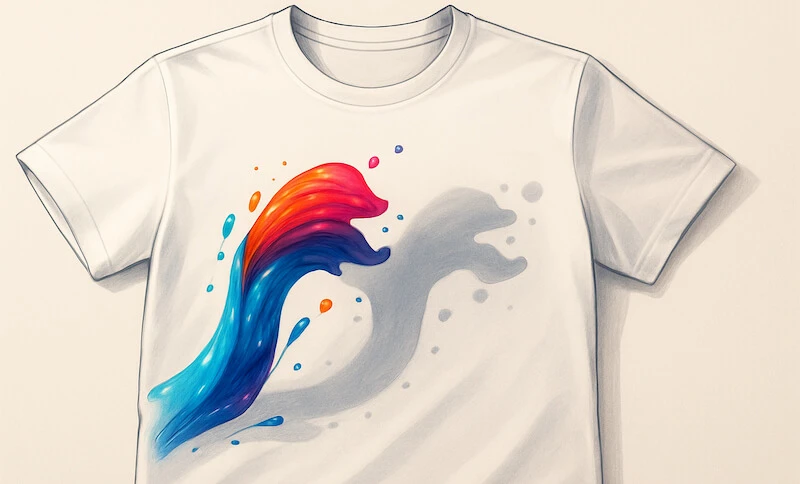When you lift the heat press after what should’ve been a perfect sublimation print, your heart sinks, a faint duplicate image, a “shadow” or halo, has appeared. This frustrating effect is known as ghosting, and it can ruin even the best designs.
Ghosting happens when your transfer paper or substrate shifts slightly during or after pressing, allowing sublimation gases to redeposit ink where it doesn’t belong. But while paper movement is the most common cause, it’s far from the only one.
Why Ghosting Happens (and Why It’s Not Just About Paper Movement)In sublimation, solid dye particles transform into gas when exposed to heat and pressure. That gas doesn’t always behave predictably. If your press temperature fluctuates, if moisture turns into steam, or if your surface coating absorbs unevenly, those dye gases can continue migrating, even after the press opens. The result is that soft, doubled image known as ghosting.
Static electricity, trapped humidity, uneven pressure, and inconsistent cooling can all amplify the effect, even when your transfer sheet stays perfectly still.

This article breaks down the scientific causes of ghosting, from gas diffusion and surface tension to heat transfer imbalance and moisture control, and shows you exactly how to prevent it.
You’ll learn how to stabilize your press environment, use anti-ghosting techniques, and fine-tune your materials for consistently crisp, professional prints.
Key Takeaways
Ghosting = unwanted dye redeposition.
It happens when sublimation gases reattach to the substrate after printing — usually due to heat, pressure, or moisture instability.
Movement isn’t the only culprit.
Temperature gradients, static charge, humidity, and uneven coatings can all cause dye migration even with perfect alignment.
Scientific control prevents it.
Stable heat, balanced pressure, controlled humidity, and correct paper choice all work together to eliminate ghosting.
Consistent workflow = flawless results.
Once you find your ideal settings, keep them consistent for every press cycle to maintain ghost-free quality.
Ghosting Explained: The Science Behind Dye Redeployment in Sublimation
Sublimation ghosting happens when dye gases continue to move after pressing, creating a faint image shadow or halo effect beside the intended design. This occurs when dye re-deposition or dye migration happens. Vaporized ink particles reattach to nearby areas instead of bonding cleanly with the substrate.
During printing, solid dye particles undergo a gas-to-solid phase transition. When exposed to the correct heat press temperature and dwell time, they should sublimate, penetrate the substrate coating, and then re-solidify in place. However, if heat transfer dynamics, moisture, or pressure fluctuate, the process becomes unstable. This instability allows vapor migration and molecular diffusion, leading to uneven substrate absorption and an unwanted print overlay.
Other physical factors, such as surface tension imbalance, static charge, or inconsistent ink vaporization, can cause color shifting, image blurring, or visible ghost print artifacts. Each is a sign that thermal and environmental conditions within the press aren’t perfectly balanced.
In short, ghosting is a byproduct of uncontrolled sublimation gas diffusion. Understanding how heat, pressure, and material coating quality interact allows printers to stabilize their process and eliminate these unwanted image echoes.
Beyond Paper Movement: Hidden Factors That Cause Ghosting
While paper shifting is the most visible cause of sublimation errors, it’s far from the only one. Even when the transfer sheet stays perfectly aligned, print misalignment and unintended transfer can still occur due to several hidden physical and environmental factors.
One major culprit is static electricity. When the paper or substrate carries a charge, dye gases can be attracted or repelled, creating a faint secondary imprint beside the original image. Similarly, poor pressure distribution across the heat press leads to inconsistent dye penetration, some areas receive more contact than others, allowing excess vapor to migrate after release.
Temperature gradients inside the press also contribute to ghosting. Fluctuations in the heat platen or lack of natural sublimation cooling can cause localized moisture vapor pressure changes. When that vapor condenses, steam effects or condensation can shift dye molecules, leaving light or blurred outlines.
Other less obvious factors include substrate warping, poor release paper adhesion, and surface contamination. These disrupt uniform contact and introduce microscopic air gaps, which redirect gas flow and weaken the transfer’s stability.
Effective humidity control, consistent heat management, and careful substrate preparation minimize these variables, ensuring that sublimation gases bond cleanly and that no residual vapor causes shadowing or double imaging.
The Science of Prevention: Stabilizing Your Press for Ghost-Free Prints
Preventing ghosting comes down to process optimization: maintaining controlled, repeatable conditions throughout production. A stable system ensures dyes sublimate and set precisely once, with no residual vapor movement.
Begin by verifying temperature calibration across the heat platen. Uneven heating disrupts thermal equilibrium, so confirm a balanced heat conduction profile using thermal strips or digital sensors. Adjust the press until readings stay uniform within a few degrees across the surface.
| 💡 How do thermal strips work on a heat press?Thermal strips are heat-sensitive labels that change color when they reach specific temperatures. Each strip contains chemical indicators that react at calibrated points—typically marked in degrees Fahrenheit or Celsius. |
Check for pressure uniformity by inspecting pad compression and hinge alignment. Inconsistent load distribution affects gas transfer and bonding strength. Periodic press maintenance, tightening hinges, leveling platens, and cleaning surfaces, keeps this stability consistent.
| 💡 How do you check heat press pressure using a test sheet?Place a sheet of plain paper between the press platens and close it under normal time, temperature, and pressure. After opening, inspect the paper: even marks show uniform pressure; light or blank areas reveal low contact, and dark spots indicate excessive force. |
Environmental control supports long-term press stability. Maintain steady humidity regulation and moisture management to keep substrates dimensionally stable. Implement a short pre-press setup routine that includes substrate pre-drying and a warm-up cycle to stabilize the system before full runs.
Use test prints or control samples to validate output after any maintenance or environmental change. These references provide measurable data for ongoing sublimation control and highlight drift before it affects production quality.
Consistency Is Key: Locking In a Ghost-Free Sublimation Workflow
Ghost-free printing depends on consistency. Once you’ve dialed in the right time, temperature, and pressure, repeat those exact press settings for every job. Maintain stable environmental conditions and handle each substrate the same way to preserve process repeatability.
A consistent workflow turns one good result into a reliable standard—delivering sharp, accurate, and flawless prints every time.
Related Topics
